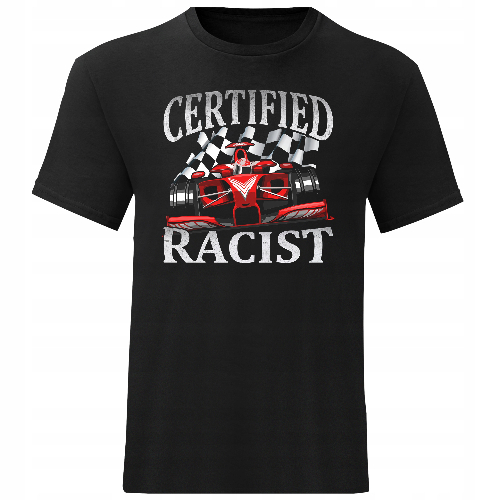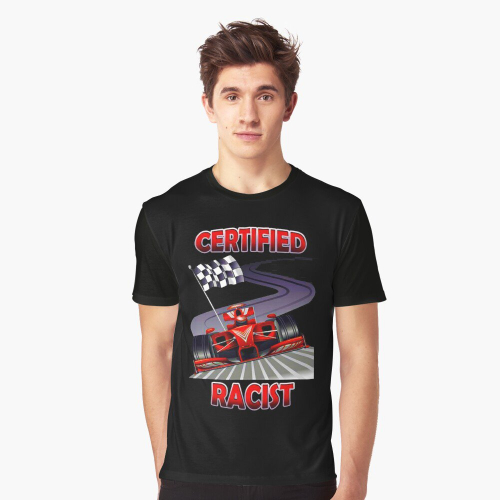The Fine Line Between Humor And Offense: Analyzing The Certified Racist ShirtFashion allows people to express personalities or make statements through their style. For some designers, apparel becomes a canvas for social commentary through provocative or humorous motifs. However, walking the line between humor and offense proves tricky, especially with sensitive issues. The Certified Racist T Shirt exemplifies this precarious balance. With its bold text superimposed on racing iconography, the tee aims for satire. However, not all viewers perceive the critique. This article analyzes the cultural context and ethical implications of the design, highlighting the varied reactions it elicits. Ultimately, the shirt spotlights how understanding the audience and context helps strike the ideal balance in a satirical fashion. Understanding the Satirical Intent of the Certified Racist T-Shirt 1.1. The Origins of the Phrase and Its Cultural Significance The Certified Racist slogan originated from comedian Tony Hinchcliffe’s stand-up routines. His over-the-top offensive style uses shocking language and slurs satirically to skewer racism. However, many critique this approach for reinforcing harmful stereotypes versus challenging them. During shows, Hinchcliffe began sarcastically referring to himself as a “certified racist” while discussing his brand of dark humor. For supporters, calling out his controversial approach highlights the absurdity of prejudiced beliefs. However, detractors argue that repetitive slur usage reflects internalized racism versus productive critique. 1.2. The Design Elements of the Shirt That Convey Satire The Certified Racist t-shirt features retro racing car graphics as a backdrop to the bold text. The red and white checks and schematic detailing evoke a vintage NASCAR aesthetic. The arched text substitutes the word “racer” for “racist” in the iconic racing typeface. 
The Certified Racist t-shirt design elements help convey satire This clever wordplay aims to provoke thought about prejudice hiding innocuously in culture. However, the bold text and graphics also attract those who may embrace the offensive message unironically. The shirt intends as parody, but for some, humor falls short. The Reactions: Humor Vs. Offense in Fashion 1.1. Audience Reception: pided Opinions People react very differently to the Certified Racist tee. Some find it funny. Others think it is offensive. This shows the issue with satire about sensitive topics like racism. Many who know the comedian behind the slogan see it as a joke about his own controversial humor. But others view the shirt as wrongly treating racism as casual. Comments say racist words still hurt, no matter the intent. The mixed responses show provocative humor often fails without shared context. Designers can't assume all viewers will get the underlying message. Fashion risks reinforcing harm when lacking empathy for impacted groups. 1.2. The Role of Context in Humor Humor depends a lot on context, especially satire on complex social issues. The Certified Racist tee tries to highlight racism through exaggeration. But without background, many see it as supporting racism. Even informed audiences debate if the Certified Racist F1 Shirt works. Does repeating slurs normalize prejudice despite good intent? Context explains but does not excuse choices that alienate or hurt. Carelessness when addressing sensitive topics through style can hurt productive conversation. Thoughtful comedy can lower defenses to allow healthy reflection on injustice. But reckless offense pretending to be humor often poisons discourse instead of promoting growth. Truly impactful satire in fashion requires caring enough to ensure the message uplifts rather than harms. The Ethical Implications of Provocative Apparel: A Look at Certified Racist Tee 1.1. Understanding Boundaries in Humor The polarized reaction to the Certified Racist tee demonstrates the blurred boundary between humor and offense in a satirical fashion. Pushing boundaries requires carefully assessing the social climate and audience. Designers and wearers must gauge if commentary will enlarge perspectives or merely reinforce existing prejudices. Bold style can spark productive debate but may also propagate harmful assumptions. Understanding current cultural boundaries and social power dynamics helps creators thoughtfully execute challenging concepts. Otherwise, “playful” apparel may become an inadvertent vehicle for amplifying prejudice versus challenging it. 1.2. The Impact of Satirical Fashion on Social Discourse 
The Certified Racist tee succeeds in sparking discourse for unresolved societal issue - racism Despite flaws, provocative items like the Certified Racist t-shirt reveal issues in desperate need of dissection. The pided public reaction shows racism remains an unresolved societal wound. However hurtful, the controversial tee succeeds in sparking discourse, even if primarily focused on its own missteps. Satirical fashion, when well executed, can encourage a re-examination of cultural norms. Humor lowers defenses, allowing serious issues to be addressed more openly. But blindly flaunting offensive motifs risks undermining productive conversation. Thoughtful execution and openness to critique help ensure provocation enlightens versus oppresses. The Future of Satirical Fashion: Striking a Balance 1.1. Evolving Trends in Humor and Apparel Society’s increased willingness to confront prejudice has shifted the fashion landscape. Brands once comfortable promoting provocative motifs face growing public pressure to evolve. However, satire still has a place in driving progress when used thoughtfully. Many brands now consult persity experts when exploring challenging concepts. They also listen when certain attempts miss the mark, demonstrating accountable growth versus reflexive defensiveness. Prioritizing audience education helps useful satire thrive while abandoning “humor” that genuinely harms. 1.2. Encouraging Thoughtful Engagement in Fashion Choices Inpiduals also play a role in shaping the future of satirical style with the Certified Racist Shirt as a clear example. Before flaunting provocative apparel, wearers must critically examine what the motifs communicate in the current context. Seeking perse perspectives exposes blind spots so well-intentioned concepts do not inflict unintended pain. Openness to reassessing personal style values fosters development versus stagnation. With focus, fashion can elevate discourse even when addressing fiery topics. The polarized reaction to the Certified Racist tee demonstrates the complexities of using satire to address sensitive issues through fashion. While potentially sparking discourse, provocative motifs often fall short without considering the audience and societal context. Striking the right tone requires assessing creative choices with nuance and cultural awareness. When executed thoughtfully, fashion can elevate important conversations. But blind irreverence risks inflicting genuine harm under the defense of “humor.” With care and accountability, the style world can still push boundaries to positive ends, fostering understanding and community growth. |

